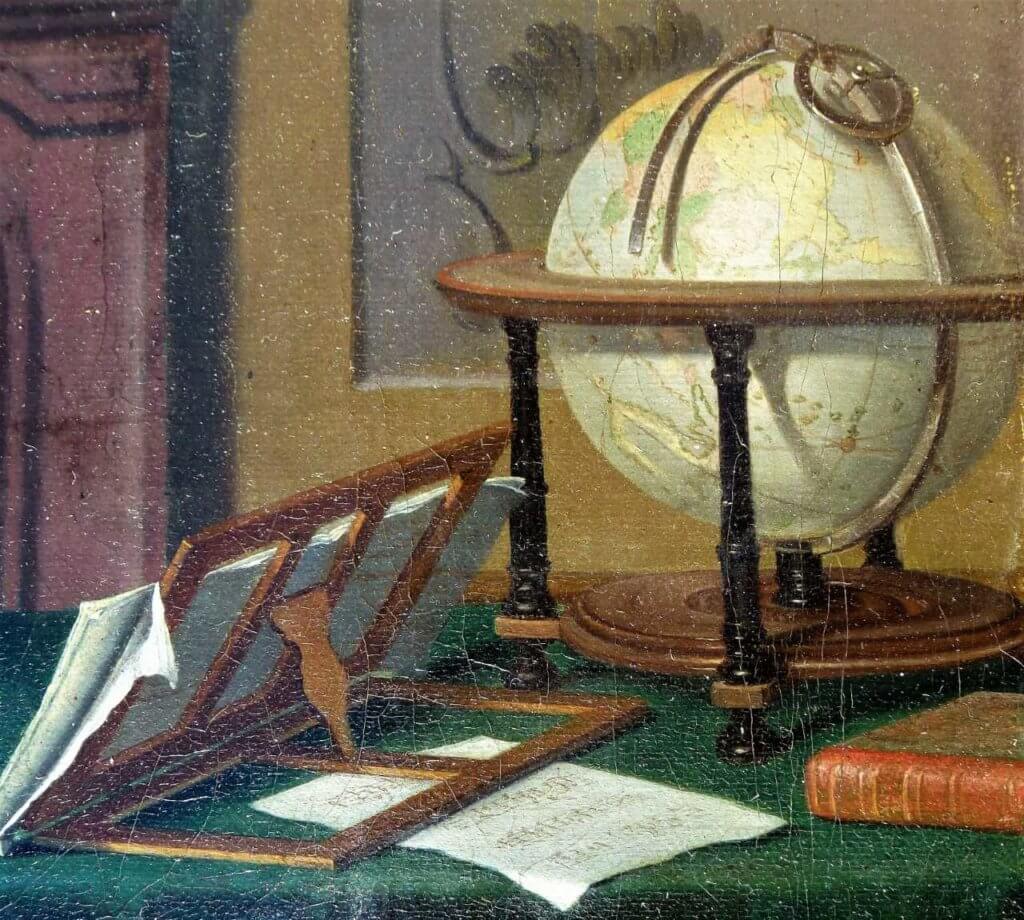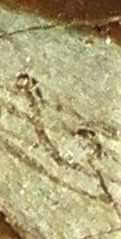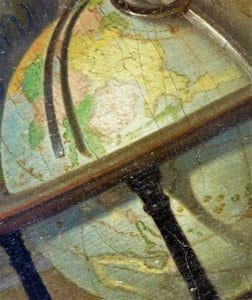Stephen Martin
Durham, United Kingdom
 |
| Figure 1. Dr Ferdinand Dejean. Oil on canvas. Unsigned. Probably by Jacobus Buys. 47 x 55 cm |
Dr. Ferdinand Dejean (1731-1797) grew up in the Bonn Court alongside Beethoven’s father and trained as a surgeon.1,2 For ten years he worked on Dutch East India Company ships from Persian Gulf islands to Sri Lanka, in Bengal, India and in Batavia – now modern-day Jakarta, Indonesia. He married Anna Maria Pack, a wealthy Anglo-Indian widow in Java. Miraculously escaping death from malaria or yellow fever, the two returned to Amsterdam in 1768. Anna died in 1773. Dejean met Mozart in Mannheim in 17773 to commission the flute concertos and quartets.4 Like Mozart, Dejean was a freemason. A newly-discovered portrait (Fig. 1) of a baroque flutist in a Dutch interior is Dejean beyond any reasonable doubt. There are many clues: a Dutch interior, religious philosophy, a medical book, East Indies, flutist, freemasonry, Mozart concerto, letter codes; another such polymath is not feasible. The painting, in a dirty state from an English collection, sold recently with little interest at an auction in London. It is signed JBF for Jacobus Buys Fecit and is in Buys’ unmistakable style. Buys lived near Dejean and probably knew him in the freemasons. Signed in the same hand, Buys depicted a sutti5 as described by Dejean in Bengal.
The room is typical of middle-class Holland in the late eighteenth-century. Few survive now. The best examples are the expensively-conserved hotels of the Herengracht in Amsterdam, some with similar wall-mounted canvasses, pilasters, panels, roundels, and fireplaces. The furniture is all or mainly Dutch, as are the two carpets and tablecloth. Dejean lived in Amsterdam on the Herengracht in the first six months after returning in 1768. He next stayed in Leiden to study medicine c. 1769-1779, a twenty-two-mile journey from Amsterdam, still feasible for seeing a masonic artist friend.
The perspective has meaning. The central “vertical” line of the carpet cuts the middle of the fireplace, like eighteenth-century Bible prints of the symmetrical paving to the gateway of Solomon’s temple and the Sanhedrin throne. The fireplace columns resemble the entrance in masonic temple models. The diagonal rug lines’ perspective vanishing point is in the centre of Dejean’s chest, in the heart, an object of masonic importance. The oddly-placed tricorn hat (Fig. 2) is a masonic triangle. Inside is a perfect circle representing the sun, not a head shape. A miniature heart is at the center. Tiny folded masonic dividers, painted with a single brush hair, in extended length join the heart to the sun.
 |
| Figure 2. Dejean’s initials |
The rich brown music stand (Fig. 3) is thinly-cut teak or mahogany from Southeast Asia. The music has “Mo…” lettered subtly in a sepia band on the second line of the title page. The work has sixteen sides, double the length of a typical eight-side concerto on the same size paper used by Mozart and Dejean’s mutual friend, Jean Baptiste Wendling.6,7 Mozart’s G- and D- major concertos take roughly twice as long to play as Wendling’s. Dejean looks to be modestly displaying a Mozart flute concerto. The original manuscripts of Mozart’s flute concertos are lost; after Dejean’s commission there is no record of them.
The last two notes of the sheet of music on the table, (Fig. 4) after a bar line, are in a “cartouche” of the stand base. They are Dejean’s initials, an F and a D. The bodies of both notes sit centrally on the top two staff lines, drawn as crotchets. There is no tune. Other notes on the page are FEDA: letters in his and his wife’s names. ‘G’ also occurs for their son Georg. The remaining possible notes B and C are not painted, and these do not occur in the names of his core family. He is clearly fingering D for Dejean on the flute. Only the right hand little finger is lifted, from the D# key. The other six fingers stretch with firm effort closing all of the tone holes.
 |
| Figure 3. AN RE on book spine |
Four letters, “AN… RE…”, are legible on the spine of the book (Fig. 5) in bright light under magnification. Subsequent marks are indistinct squiggles; only AN RE is clear. The chance of these letters being random is 1 in 456,976. The only book to have been found in extensive searches, with An… and Re… in frontispiece title words and on the spine, is Anatomia Reformata. Original editions of seventeenth- and eighteenth-century print runs still figure commonly in today’s libraries and book sales. It was essentially the Gray’s Anatomy of its day. Books circulated for well over a century, judging by dates next to doctors’ signatures. Anatomy books were durable, with complex, expensive plates and strong bindings, made to be thrown around. Anatomia Reformata was published in Leiden where Dejean lived and studied later in his career. AN RE could mean something extra. AN comprises the first two letters of his father Anton and of Anna, who had both died by 1773. RE is the medical and masonic invocation of Mercury or the Egyptian sun god. Is it a masonic prayer for the departed? It has to mean something. The artist would not have gone to the time, trouble, and expense otherwise.
The globe (Fig. 6) has similarly hidden details. It is only 57 mm across. The red spot on the west coast of India’s north provinces marks Bombay. Anna Dejean was born there, north of Goa, on the red-green border of the Maratha Confederacy and Mysore. Several Pack family members are in the Bombay registry. The globe is late seventeenth- or early eighteenth-century. Such globes needed the longitude ring placing into a groove on the base of the stand, to set the angle of the axis for display, which is tricky, making chance displays of meaningful information unlikely. The absent eastern Australian coast predates James Cook’s 1771 charts. The curved steel pointer is over the Bay of Bombay, where Dejean travelled as a ship’s surgeon. It aligns with Batavia, immediately below the wooden equatorial mount from the direction of the pointer. Batavia is painted abraded into a white spot from repeatedly pointing to it. The pointer’s shadow over Siam, east of the green Malay peninsula, is perhaps significant. The fall of Siam to Burma in 1767 was a regional crisis for the Dutch and a likely factor in Dejean’s departure.
 |
|
| Figure 4. The globe showing South East Asia |
The painting above Dejean’s head shows goats separated from sheep on either side of a vertical line through his nose. Matthew 25: 31-46 describes how God shall put sheep to his right and goats to his left, then send the cursed to eternal punishment or the righteous to eternal life. We know Dejean studied judgement. He auctioned Bunyan’s The Pilgrims Progress in 1790 with other theological books.8
There are symbols of his mortal life horizontally in the center. The head/mind crosses the line between divine judgement and life, while the waist caps a parable of guilt. He is sandwiching his life in morality.
The strong theme of the lower third of the picture is legs – those of the console, footstool, and chair uncovered and those of Dejean and the table covered. Baring legs in masonic rituals derives from Isaiah 47: 2-3, analogous to exposing shame to God. Dejean had probably lost his wife by the time this was painted, possibly in childbirth. He knew it was pure chance he had survived the tropics. Also, he had something of a misspent youth, having gone bankrupt and written to his father9 about it. Death was close and judgement was serious.
Time and life are ticking by on the clock. It looks like ten past six, so a fair amount of time is left, but not forever. The clock maker’s plate shows “Lo…,” suggesting a maker from London. We know Dejean went to London in 1778, when he befriended James Cook’s second expedition scientist Georg Forster. Dejean visited London again in 1781. The silvered brass chapter ring, pendulum aperture, and engraved steel name disc in the striking hand aperture, as well as the general design, are in the manner of several London clockmakers: James Chester who traded 1770-1785, John Dowson active in the 1770’s, Sam Stirling and Benjamin Ward c.1780, and Deveraux Bowly who traded until 1773. Dejean’s will inventory described a mathematical clock, flutes, sheet music, and family portraits.1
His forehead is pale from wearing a hat, his cheeks are very red. His eyelids and upper cheeks, especially on his left, show the wrinkles of sun damage. He also has red eyes from tropical sun exposure. He wears plain dress; no need for fashion, and practical. Individually-painted wig hairs and eyebrow hairs are a Jacobus Buys trademark. Nathaniel Dance painted the hard-working pragmatist Capability Brown in 1773 wearing a 1740s wig. Jane Austen was tickled at how her lawyer great uncle Francis, in Sevenoaks, kept his old wig, decades out of fashion, looking “like a Bishop.” Some men were not fussy, even scorning fashion to a rebellious degree. Dejean’s wig has an exaggerated forehead point and six curls on each side, typical of the 1740’s; apparently an attachment from early adulthood.
The suggestion of a man alone, with no smile of reason, is of a man in grief; that Dejean’s wife is not in the picture suggests bereavement. The possible masonic prayer for her on the book spine is further evidence of her passing. Overall, the date of the picture fits 1778 or soon after.
Like a fingerprint, with a limited number of points to prove uniqueness, this portrait is Dr. Ferdinand Dejean beyond any reasonable doubt. One does not add, but rather multiplies factors to calculate the size of a probability pool. This painting presents a rare chance to appreciate personalized Enlightenment symbols from the remarkable life and mind of a doctor close to Mozart.
End notes
The portrait of Dr Ferdinand Dejean may be used freely in the public domain worldwide, in dissertations, journal articles, handouts and lectures, for the purpose of study, teaching or academic journal publishing, on citation of © Baan Dong Bang Museum and Education Centre, Thailand. It must not be used for commercial profit without specific agreement with the museum directors and trustees. See bdbec.wordpress.com
References
- Otto Bleker, Frank Lequin. Ferdinand Dejean. 1731-1797. VOC-chirurgijn, wereldburger en opdrachtgever van Mozart. Stichting Uitgeverij Noord-Holland, Wormerveer, 2013.
- Otto Bleker. Ferdinand Dejean (1731-97): Surgeon of The Dutch East India Company, Man of The Enlightenment, and Patron of Mozart. The Historian Vol. 78, Nr. 1, Spring 2016, 57-80.
- Stephen Martin, Otto Bleker, Falk Steins. Ferdinand Dejean – Patron of Mozart’s Flute Music. Pan. The Journal of the British Flute Society. Dec 2015. Pp 32-34.
- Flute concerto in G K 313, Flute Concerto in D K 314, Andante in C K 315, Flute Quartets in D K 285, in G K 285a, in C K 285b (probable), and in A K 298 (possible). The Flute and Harp Concerto, K299/297c, was a separate commission for the Duke of Guînes.
- The Morgan Library, New York, USA.
- Emily Jill Gunson. Johann Baptist Wendling (1723–1797): Life, Works, Artistry, and Influence; including a Thematic Catalogue of all his Compositions. Ph.D. dissertation, University of Western Australia, 1999.
- Catherine Sprague, William Cowdery. Mozart’s Salzburg Years (1756-1781): Insights and Images. Pendragon Press, Hillsdale NY, 2017.
- Catalogus partis minoris continens libros medicos anat. chirur. bot. pharm. chem. & hist. nat. scriptores &c. quos collegit vir doctissimus et expertissimus Ferdinandus Dejean, ALM Phil & Med Doc. Luzac and van Damme, Leyden, 1790. Landesbibliothek Oldenburg Digital.
- Ferdinand Dejean to Anton Dejean, 2 Nov 1756, 5 Feb 1757. Landesarchiv, Nordrhein Westfalen, Germany.
STEPHEN MARTIN, MBBS, MRCPsych, LTCL (flute), is a retired British neuropsychiatrist. He did functional neuroimaging research as Visiting Professor, University of Sunderland School of Sciences. A licentiate flutist, Stephen was recently on a sabbatical as Professor in the College of Music, University of Mahasarakham, Thailand. He won the University of Newcastle upon Tyne George Henderson scholarship for art history research and is adviser to the Baan Dong Bang Museum.
Highlighted in Frontispiece Volume 10, Issue 4– Fall 2018
Spring 2018 | Sections | Music Box

Leave a Reply